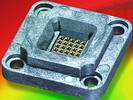

The land grid array socket is another option for device manufacturers to package devices without any terminations on the bottom. Although not technically accurate, the easiest way to envision a land grid array, or LGA device, is to picture a semiconductor with nothing but tiny round gold plated pads on the bottom. (If the device were a BGA, a BGA ball would be soldered to each pad.)
In order for LGA devices to get connected to a PCB, there must be some intermediary device with pins, or springs, or something, that can spring up and make contact with the little windows. So, almost by definition, a socket is required in order to connect an LGA device with its target PCB. Also, almost by definition, there must be some kind of cover or hold down mechanism that pushes the little windows of the device against the contacts of the intermediary connector.
This requirement causes a 'catch-22' dilemma: there must be enough pressure (hold down force) for each of the windows to electrically connect to each of the contacts - but there is only so much pressure one can apply. Even if the required pressure is only one ounce per contact, today's pin counts of >1000, would require hold down forces of 20, 30, and even 40 pounds or more - making any hold down mechanism very difficult to implement (not to mention the possibility of damaging the target board!)
The biggest reason for terminating a device such as an LGA is to achieve higher pin counts (number of outputs) with smaller packages. At the same time, it is very important to keep the electrical path of each connection as short as possible. Previous packaging options, like pin grid array (PGA) and quad flat pack (QFP), all left something to be desired in achieving these goals. With new requirements such as high-end PCs requiring 1000 and more pin counts, even BGA is not an option since the large footprints can not stand the forces on the solder joints that are caused by 'thermal mismatch' (the materials of the semiconductor device have different coefficients of expansion than those of the target PCB). Only a 'Z-axis' connection can overcome the thermal mismatch problems.
LGA advantages
* Ease of device manufacture: Just add gold plated round pads to the bottom of the device (microprocessor).
* High I/O: Pin to pin spacings of 1,27 mm, 1 mm and below can be achieved with LGA. At a 1 mm pitch, 1225 I/Os can be contained in a 35 x 35 grid that is less than 9,7 square cm.
* Low inductance: The distance from the bottom of the device being socketed to the target board can be less than 2 mm with some LGA socket designs.
* Ease of upgrade: Microprocessors can be easily removed and replaced.
* No 'keep out' area required: New versions of Z-Axis connectors can be attached in position on one side of the target board, eliminating the need for keep out areas required by previous termination styles.
* Device cost: Devices cost less to manufacture because terminations (pins or balls) are no longer required.
* Elimination of co-planarity problems: LGA sockets can be manufactured for spring movement of 0,4 mm, which 'takes up the slack' when there is a problem with co-planarity on the bottom of the device.
* Low mating force requirements: Stamped and formed socket contacts, when gold plated, can be designed requiring only 20 to 35 grams of force per position to achieve reliable mating.
LGA disadvantages
Difficulty of soldering. The very high pin counts and the large footprints they necessitate require a high degree of surface mount soldering experience and sophisticated soldering equipment. This is similar to the 'learning curve' that attaching BGA sockets initially requires.
Solution
After years of experience and research, Aries has developed a unique LGA solution. Your local distributor has full details on the LGA/BGA socket for high performance ASICs for 1,00-1,27 and 1,50 mm pitch.
| Tel: | +27 11 887 7879 |
| Email: | [email protected] , [email protected] |
| www: | |
| Articles: | More information and articles about Sivan Electronic Supplies |

© Technews Publishing (Pty) Ltd | All Rights Reserved